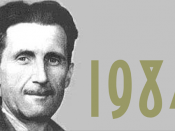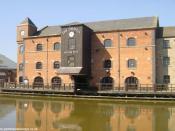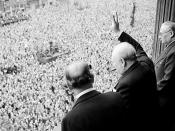Clarity: 1984 Number of Words: 2882 Class: ENG 4A Teacher: S. Kennedy Student: Lee Bowman Due Date: Fri, Dec. 22 In George Orwell?s 1984, Mr. Orwell depicts the indignity of human suffering and pain with startling clarity. ?In late 1945, Orwell went to the island of Jura, off the Scottish coast. He settled there in 1946 and wrote Nineteen Eighty-Four. However, the islands climate was unsuitable for someone suffering from tuberculosis and Nineteen Eighty-Four reflects the bleakness of human suffering, the indignity of pain. Indeed he said that the book wouldn?t have been so gloomy had he not been so ill.? This picture of desperation is painted through the setting, the characters, and the plot. The film, 1984, directed by Michael Radford, uses these same elements to convey this message.
In both the film and novel, the setting was an element that communicated the intended message very strongly. The scenes have an overwhelming air of a rotting, decimated world.
From the horrible living conditions, to the bombed out buildings, to the constant surveillance each citizen lives under, all of these things contribute to the sense of a suffering world.
One of the main conveyers of desperation is the terrible living conditions the citizens of Oceania live under. These conditions are illustrated every time Winston eats a meal at work. ?In the low-ceilinged canteen, deep underground?[it was] very full and deafeningly noisy. From?the counter the steam of stew came pouring forth, with a sour metallic smell which did not quite overcome the fumes of Victory Gin.?(p. 42) In 1984, the film, the canteen is nearly exactly as it is described in the novel. However, in the film 1984, the director further elaborates on the food that the characters are given. Winston is staring, with an expression of quiet disgust, at...


